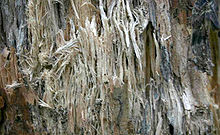From: Treseder KK, Lennon JT. 2015. Fungal traits that drive ecosystem dynamics on land. Microbiology and Molecular Biology Reviews 79:243-262.
Fungi use extracellular peroxidases to oxidize lignin, ostensibly to obtain access to cellulose, N, and other nutrients that are physically or chemically protected by lignin in plant litter (Tien and Kent Kirk 1983, Martínez et al. 2009, Floudas et al. 2012, Riley et al. 2014). Because lignin is the second-most common biopolymer on land (Bugg et al. 2011), lignin degradation can have global consequences for C cycling (Schlesinger 1977). In addition, because lignin is often cross-linked with other compounds in plant litter, fragmentation of lignin by fungi can facilitate the decomposition of these other compounds and broadly accelerate litter turnover in ecosystems (Talbot and Treseder 2012). Although some bacteria can break down lignin, this role is often thought to be dominated by fungi (Bugg et al. 2011). In fungi, lignin degradation is conducted by high-oxidation potential class II peroxidases, which are categorized as lignin peroxidases (LiP), manganese peroxidases (MnP), or versatile peroxidases (VPL) (Tien and Tu 1987, Martínez et al. 2009, Ruiz-Dueñas et al. 2009). Only a fraction of fungal taxa possess genes encoding these enzymes, and they are largely restricted to the class Agaricomycetes within the Basidiomycota (Floudas et al. 2012, Riley et al. 2014). Historically, wood decomposers that could decompose lignin and cellulose were often classified as “white rot” fungi; they were distinguished from “brown rot” fungi, which decomposed cellulose alone. Nevertheless, recent studies indicate that intermediate types exist (Floudas et al. 2012, Riley et al. 2014), which may require us to re-evaluate our use of these terms.
Fungal genes for lignin peroxidase production
Possession of lignin peroxidase genes varies most at the order level:
Phylogenetic distribution of lignin peroxidase genes:
Lignin peroxidase genes are most abundant in free-living filamentous fungi:
Bugg, T. D. H., M. Ahmad, E. M. Hardiman, and R. Rahmanpour. 2011. Pathways for degradation of lignin in bacteria and fungi. Nat Prod Rep 28:1883-1896.
Floudas, D., M. Binder, R. Riley, K. Barry, R. A. Blanchette, B. Henrissat, A. T. Martínez, R. Otillar, J. W. Spatafora, J. S. Yadav, A. Aerts, I. Benoit, A. Boyd, A. Carlson, A. Copeland, P. M. Coutinho, R. P. de Vries, P. Ferreira, K. Findley, B. Foster, J. Gaskell, D. Glotzer, P. Górecki, J. Heitman, C. Hesse, C. Hori, K. Igarashi, J. A. Jurgens, N. Kallen, P. Kersten, A. Kohler, U. Kües, T. K. A. Kumar, A. Kuo, K. LaButti, L. F. Larrondo, E. Lindquist, A. Ling, V. Lombard, S. Lucas, T. Lundell, R. Martin, D. J. McLaughlin, I. Morgenstern, E. Morin, C. Murat, L. G. Nagy, M. Nolan, R. A. Ohm, A. Patyshakuliyeva, A. Rokas, F. J. Ruiz-Dueñas, G. Sabat, A. Salamov, M. Samejima, J. Schmutz, J. C. Slot, F. St. John, J. Stenlid, H. Sun, S. Sun, K. Syed, A. Tsang, A. Wiebenga, D. Young, A. Pisabarro, D. C. Eastwood, F. Martin, D. Cullen, I. V. Grigoriev, and D. S. Hibbett. 2012. The Paleozoic origin of enzymatic lignin decomposition reconstructed from 31 fungal genomes. Science 336:1715-1719.
Martínez, Á. T., F. J. Ruiz-Dueñas, M. J. Martínez, J. C. del Río, and A. Gutiérrez. 2009. Enzymatic delignification of plant cell wall: from nature to mill. Curr Opin Biotechnol 20:348-357.
Riley, R., A. A. Salamov, D. W. Brown, L. G. Nagy, D. Floudas, B. W. Held, A. Levasseur, V. Lombard, E. Morin, R. Otillar, E. A. Lindquist, H. Sun, K. M. LaButti, J. Schmutz, D. Jabbour, H. Luo, S. E. Baker, A. G. Pisabarro, J. D. Walton, R. A. Blanchette, B. Henrissat, F. Martin, D. Cullen, D. S. Hibbett, and I. V. Grigoriev. 2014. Extensive sampling of basidiomycete genomes demonstrates inadequacy of the white-rot/brown-rot paradigm for wood decay fungi. Proc Natl Acad Sci U S A 111:9923-9928.
Ruiz-Dueñas, F. J., M. Morales, E. García, Y. Miki, M. J. Martínez, and A. T. Martínez. 2009. Substrate oxidation sites in versatile peroxidase and other basidiomycete peroxidases. J Exp Bot 60:441-452.
Schlesinger, W. H. 1977. Carbon balance in terrestrial detritus. Annu Rev Ecol Evol Syst 8:51-81.
Talbot, J. M. and K. K. Treseder. 2012. Interactions between lignin, cellulose, and N drive litter chemistry-decay relationships. Ecology 9:345-354.
Tien, M. and T. Kent Kirk. 1983. Lignin-degrading enzyme from the hymenomycete Phanerochaete chrysasporium burds. Science 221:661-663.
Tien, M. and C. P. D. Tu. 1987. Cloning and sequencing of a cDNA for a ligninase from Phanerochaete chrysosporium. Nature 326:520-523.



